How I Transition Plants from Soil to Semi Hydroponics
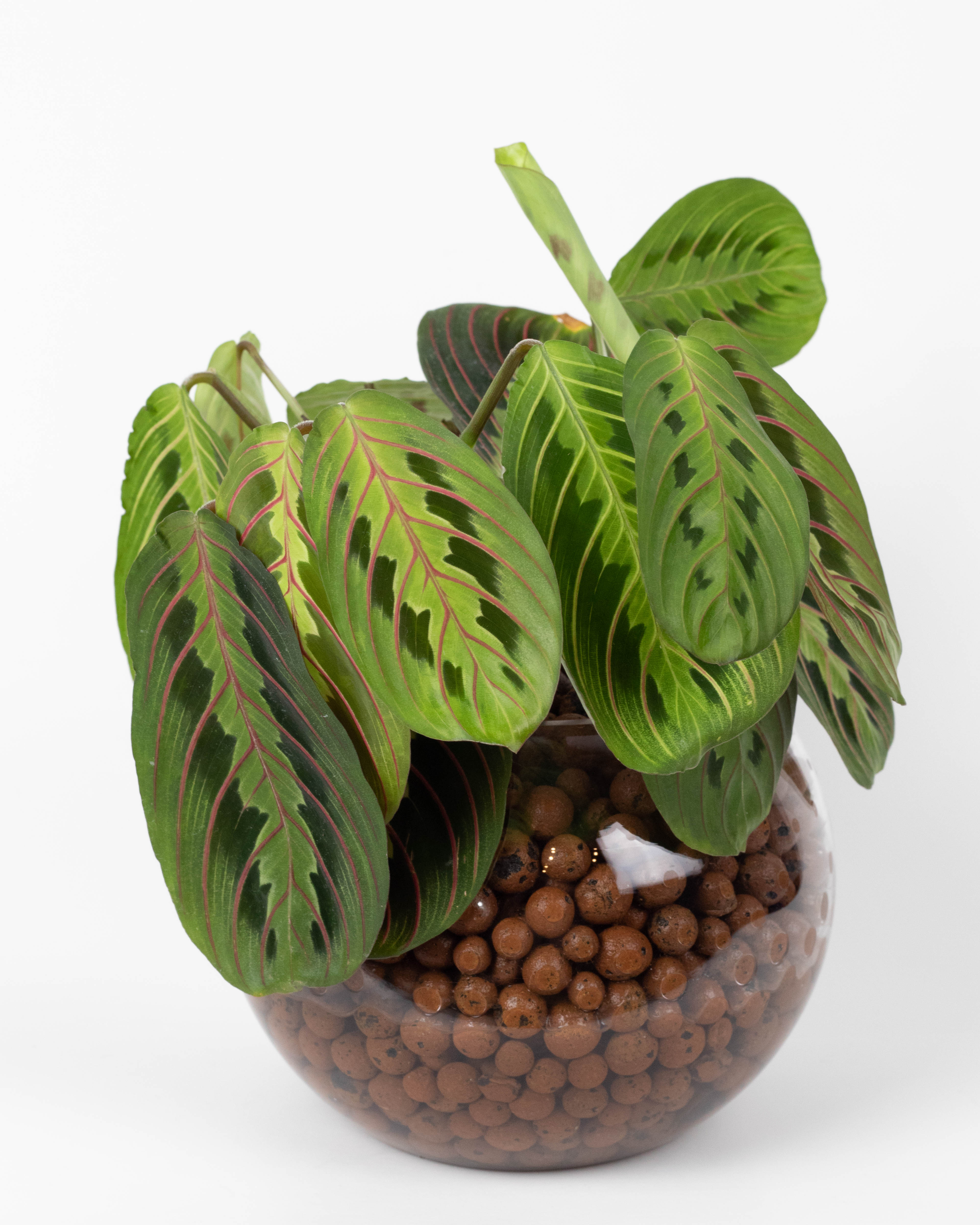
In my experience of converting plants, i’ve found that there are a lot of plants that do great going straight from soil to semi hydroponics and convert without batting an eye. They adjust quickly to growing in a new media and almost immediately begin to push out new root and leaf growth. Its as easy as removing the soil, washing the roots and I’m good to go! The easiest plants to convert straight from soil in my experience have been pothos, scindapsus, trailing philodendrons, spider plants, monsteras, ficus (elastica, audrey, lyrata, altissima) and schefflera etc.
NOTE: It’s important to keep in mind that some plants going straight from soil into semi hydroponics will shed the outer layer of their old soil roots and grow new white roots that are adapted to growing in a soil free media – which is a natural process! As long as the plant looks healthy and is pushing out new root and leaf growth, all is well.
Eventually any soil and remaining plant waste will be washed away when you flush your pot. However, it is still a good practice to check on your plants roots every couple of weeks after first planting to clean out any shedded root waste or roots that didn’t make the transition. In time only clean white roots will remain.
Some plants on the other hand are easier to convert with a bit of transitioning after being removed from soil.
In my experience the plants that benefit most from transitioning include:
- Plants that have roots that are too thin, delicate or fibrous to easily remove the soil from.(e.g. peperomias, pileas, marantas, banana plants etc).
- Plants with compromised root systems (the root system is small and weak / soil removal was difficult and many of the roots were damaged or needed to be trimmed
- Plants that are sick, struggling or have stem or root rot.
- Plants that go into shock easily after soil removal (e.g. watermelon peperomias, pilea peperomioides)
Different Methods to Transition Plants to Semi Hydroponics
The most important step when converting a plant from soil to semi hydroponics is soil removal. Taking that extra time to be very thorough with getting as much soil off the roots as you possible can really save you from future headaches and root issues later down the road.
However, even with that said and done, some plants may have compromised or weakened root systems before or after soil removal. Both LECA and Water propagation methods can be used to promote root growth and strengthen a weak or struggling root system before planting in semi hydroponics.
Furthermore, for plants that have roots that are impossible to remove the soil from, it is often easier to cut the soil roots off completely and grow new roots in water propagation or LECA propagation.
Water Propagation
With water propagation, I place the plant or cuttings in a glass jar with water to encourage new root growth. Once the root system has grown substantial enough to support the plant, it can be either be moved to LECA propagation or straight into semi hydroponics.
TIP: Since the roots of pileas and peperomias are next to impossible to remove the soil from and they propagate very easily, I cut the roots off the plant completely and grow new roots in water propagation. Once roots appear, I move the cutting to LECA propagation.
LECA Propagation
With LECA propagation, I place the cutting or plant in a glass jar with LECA, keeping the waterline at a 1/3 the height of the jar. I find regular tap water works just fine and I only start adding nutrients once I move to a semi hydroponic setup.

If the plant already has some roots, it’s okay if the roots are not submerged below the waterline (especially if there is still some soil remaining). The wicking ability of LECA will pull water up towards the roots through capillary action, keeping the LECA saturated.
For unrooted cuttings the same principal applies, although you may want to submerge the ends of the stems if its a finicky or water loving plant (I see you watermelon peperomia!). In either case, new roots will begin to grow along the nodes of the stem in LECA. Once root growth is substantial, the plant can be moved to semi hydroponics.
NOTE: LECA propagation is a great transitioning step for moving a plant to semi hydroponics.The air spaces within and between the LECA, along with the constant supply of water, provide a balanced root zone environment ideal for root growth! Furthermore, roots propagated in LECA are already adapted to growing in a soil free media, making the move to a semi hydro setup much more seamless.
Propagation Box, Bag or Dome
It can be beneficial to place plants propagating in water or LECA inside a propagation box, clear garbage bag, ziplock bag, or dome.
The idea is to create greenhouse type environment that keeps the humidity high and the LECA saturated while new roots are growing. Hoyas in particular love really high humidity when growing new roots and really benefit from a propagation box or bag. Just make sure if you’re using a box or bag that it is not air tight so that there is some air flow (small holes in the top of the box, or a small space left open in the bag works great).
Transitioning Different Types of Plants to Semi Hydroponics
Thin, Delicate and Fibrous Rooted Plants
Plants such as peperomias, marantas and plieas (amongst others), have very thin, delicate and fibrous roots. These types of roots are very difficult, if not impossible, to remove the soil from without severely damaging or losing the majority of the root system. Too much remaining soil could lead to root decay and a damaged root system could send the plant into shock.
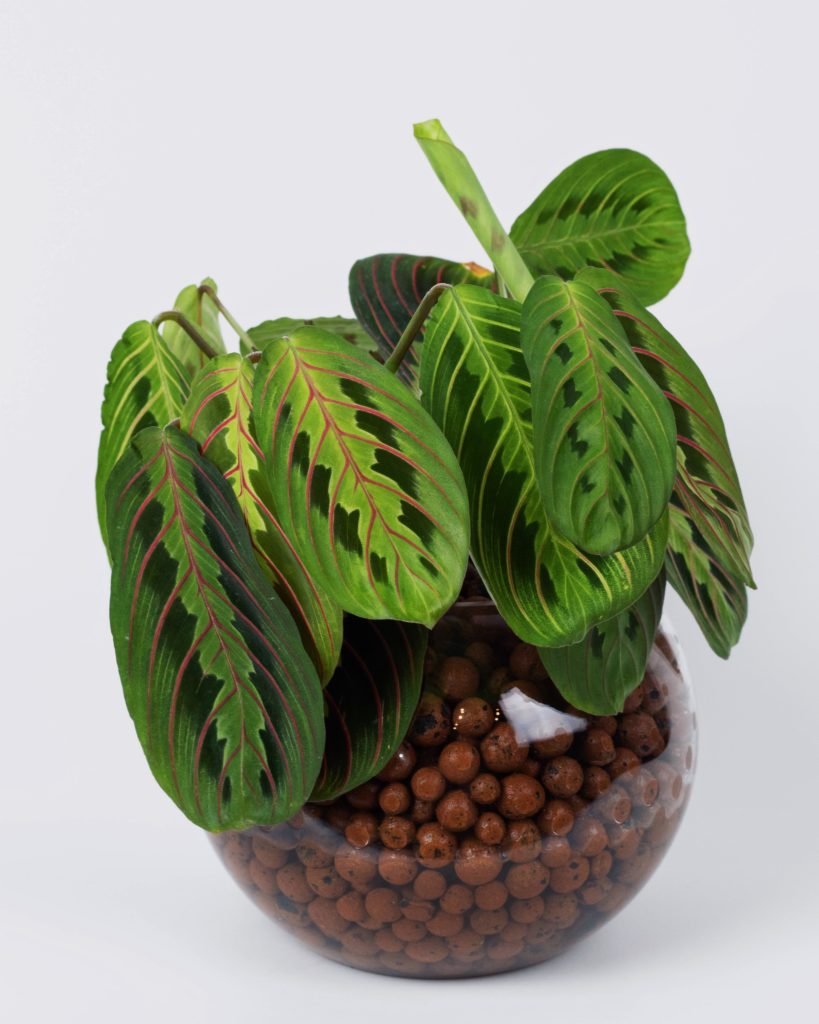
Maranta cuttings growing new roots in LECA propagation 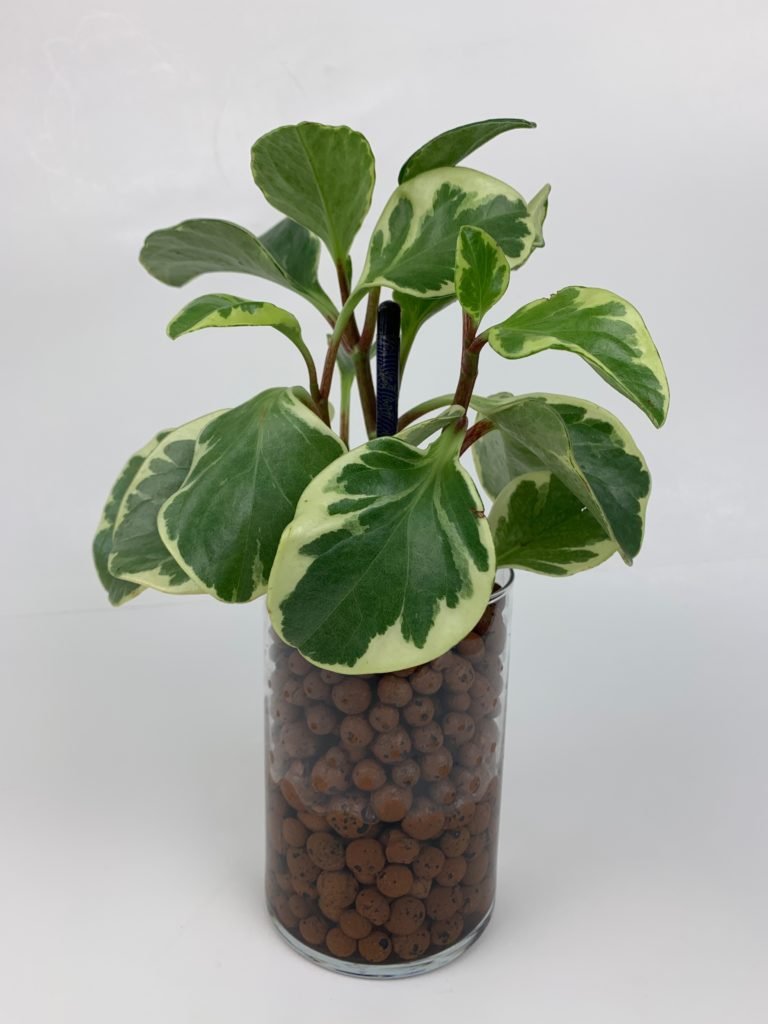
Peperomia Obtusifolia growing new roots in LECA propagation
For these reasons I find it’s easier to cut the soil roots off completely and propagate new roots in water or LECA propagation before planting in semi hydroponics. Just make sure to include sections of the plant that have part of the stem with nodes, as this is where the new roots will grow from.
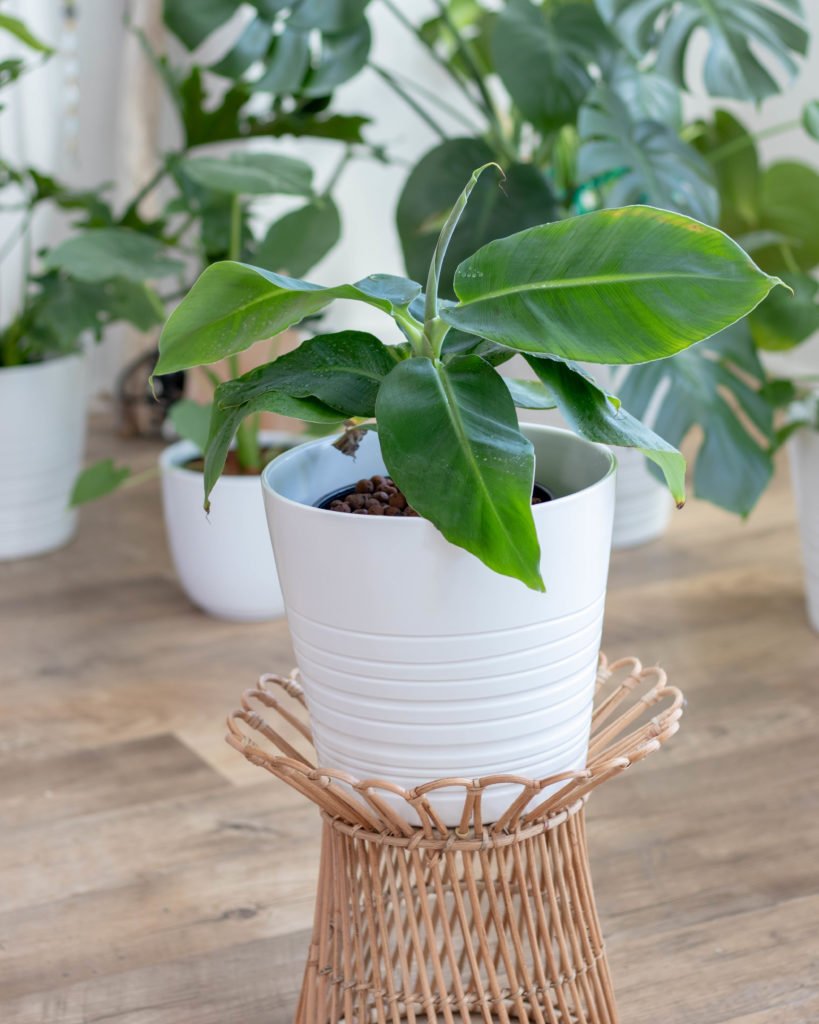
Semi Hydroponic Banana Tree 
Pilea peperomioides growing new roots in LECA propagation
With my banana tree, its fibrous roots were coated in extremely hard to remove soil. I ended up using an old tooth brush to gently scrub off as much of the soil as I could (I don’t necessarily always recommend this, as it can be quite harsh on the roots, but I was determined to have this baby soil free!). By the time I was done, the majority of the fine roots had been lost with only the main roots remaining.
I made the mistake of immediately planting it in semi hydroponics instead of transitioning it. By no surprise, by the next day the plant had gone into shock and its leaves were limp. I’ve noticed from experience that this tends to happen when the root system has suffered too much damage from soil removal and can therefore no longer support the plant.
To remedy the situation, I moved the plant out of semi hydroponics and kept it in a jar of water. Its leaves quickly perked back up and by the end of the week, the main roots had pushed out a crazy amount of new fine root growth! With the root system recovered I was then able to plant in a semi hydroponic setup where it has since flourished.
Plants with Compromised Root Systems
For plants that have a small or weak root systems or have lost a lot of roots during soil removal and their root system has been compromised, I prefer to first transition the plant in either a jar with water or LECA before planting in semi hydroponics. Both are a great way to help a plants root system recover and to encourage new root growth.
Glass jars are great since they also allow you to watch as new roots grow and to see if any of the roots that were damaged have died off. They also keep the humidity high and the LECA saturated while the plant is growing new roots and transitioning to a new medium.

Philodendron Selloum transitioning to Semi Hydroponics using Water Propagation 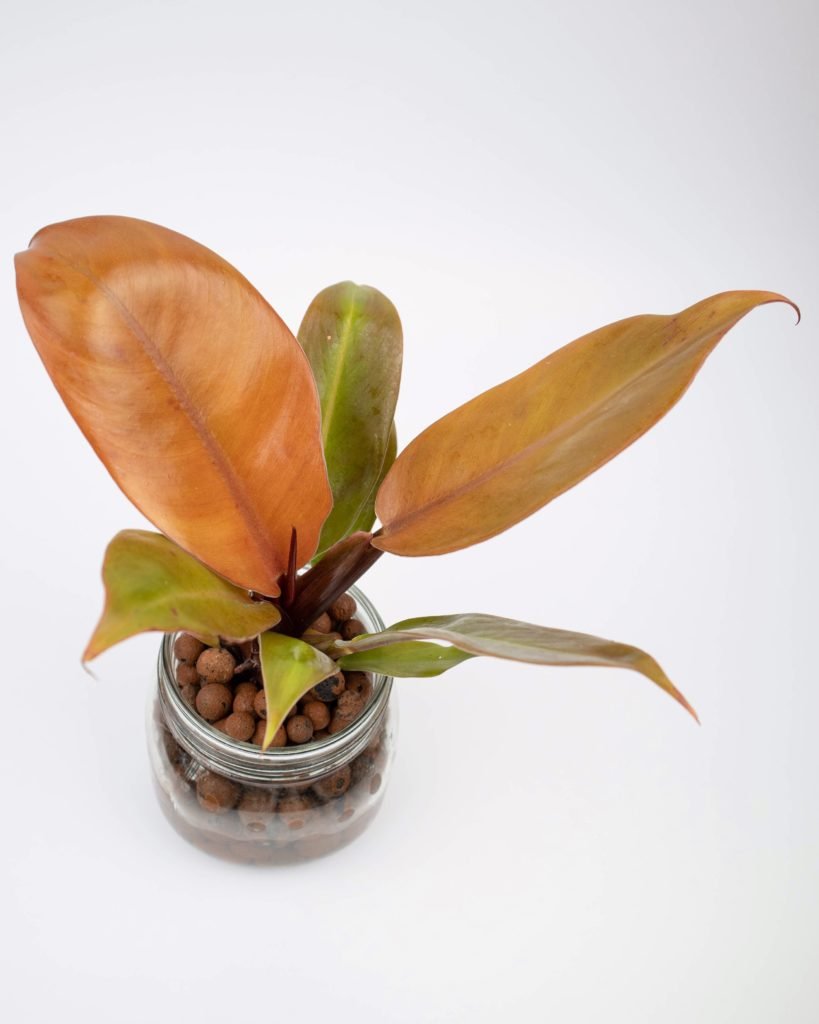
Promoting root growth on a philodendron prince of orange using a jar with LECA
For my philodendron Selloum, like my banana plant, after removing the soil, many of the finer roots were lost with only the main roots remaining. Since the root system was compromised, I kept it in water for a week to prevent the plant from going into shock and to encourage new root growth. This allowed me to see if any further damaged roots fell off and to observe new root growth. Once I was confident that the root system was healthy I moved the plant from water to a semi hydroponic set up.
My philodendron Prince of Orange was another case of a comprised root system after soil removal. To help its roots recover and ease its transition into semi hydro, I decided to first transition the plant in a jar with LECA.
Sick, Struggling Plants or Plants with Stem or Root Rot
If a plant is sick, struggling or has stem or root rot, it is usually better to first transition the plant. This allows you to treat the plant and keep an eye on the root system to ensure it is healthy before planting in semi hydroponics.
Going from soil into semi hydroponics can be a bit of a shock even if the plant is already healthy (since it has to adapt to a new medium), so extra care should be taken if the plant is already struggling. If it is a plant that has many sections or can be divided, it would be a good idea to treat each section separately rather than propagating it all in one container.
For root rot, remove the plant from its pot and rinse all the soil from the roots, cutting away all the infected and dead roots. I find its usually best to start the plant in water propagation to help its root system recover as well as to keep an eye on the health of the roots over time. This also allows you to remove any further roots that might die off and to change the water easily.
If its a plant that propagates easily it might be best to cut the roots off entirely and grow new ones. Once the root system starts to look healthy, you can move the plant to LECA propagation.
For stem rot, cut above the part of the stem that is infected. If its a plant with only one main stem this may mean that you’ll have to lose the root system entirely; in which case, you can propagate new roots in water or LECA propagation. If its a plant like an alocasia that has rhizomes roots, make sure to cut as much of the rot off as possible but try to salvage a part of the rhizome since this is where new roots will grow from.
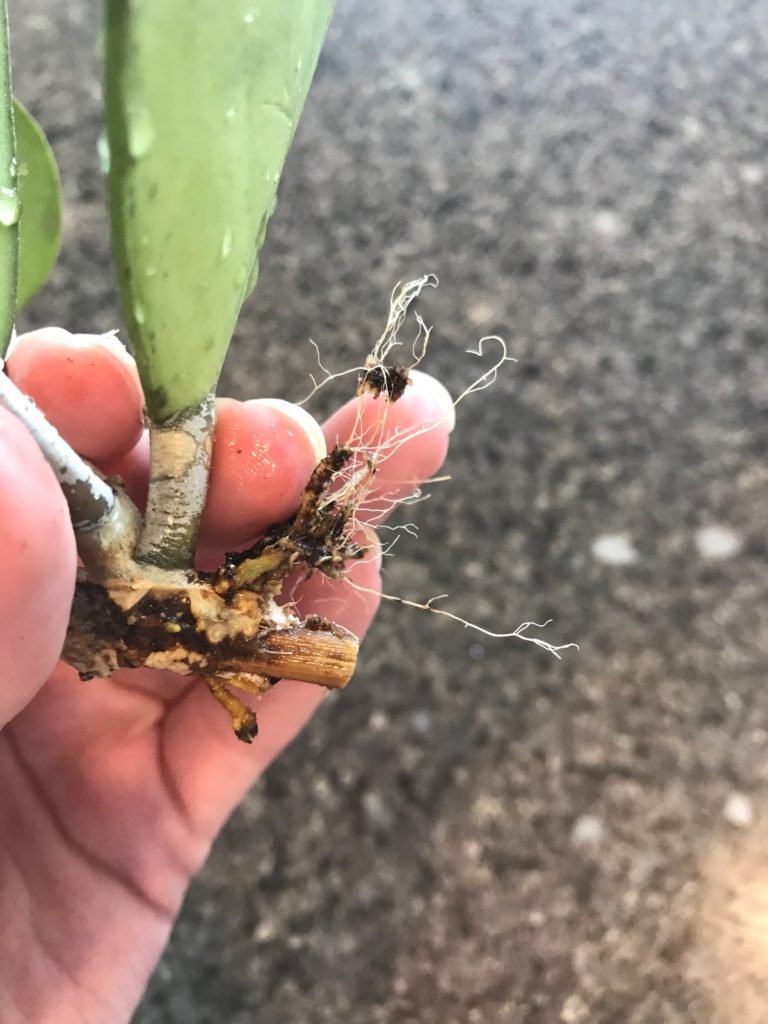
Hoya Kerrii with Stem and Root Rot 
Hoya Kerrii with stem and root rot removed and ready for propagation
Finicky Plants that go into Shock Easily
Some plants can be super finicky after being removed from soil and can very easily go into shock if planted immediately in semi hydroponics. Watermelon peperomias and pilea peperomioides are both great examples of plants with thin and delicate root systems that are very hard to remove the soil from. Even if the majority of soil is removed, there will likely not be enough root system left to support the plant.
I’ve learned the hard way trying to keep some of the root system while converting pileas and watermelon peperomias. In both cases, the plants went limp within a few hours and I ended up having to cut off the old root system entirely and propagate new roots in water or a jar of LECA.
Mature Plants with Large Root Systems
Some plants, like monsteras and philodendrons, may be more forgiving converting at a larger size. You just need to make sure to remove as much of the soil as possible as well as to trim any roots that are dead or damaged. There is however always the risk that a larger plant might go into shock from being removed from soil and have a hard time adapting to a new media.
After planting a mature plant in semi hydroponics, it is good practice to remove the plant from the pot every few weeks to check on the root system and trim any dead roots that might have not have taken.
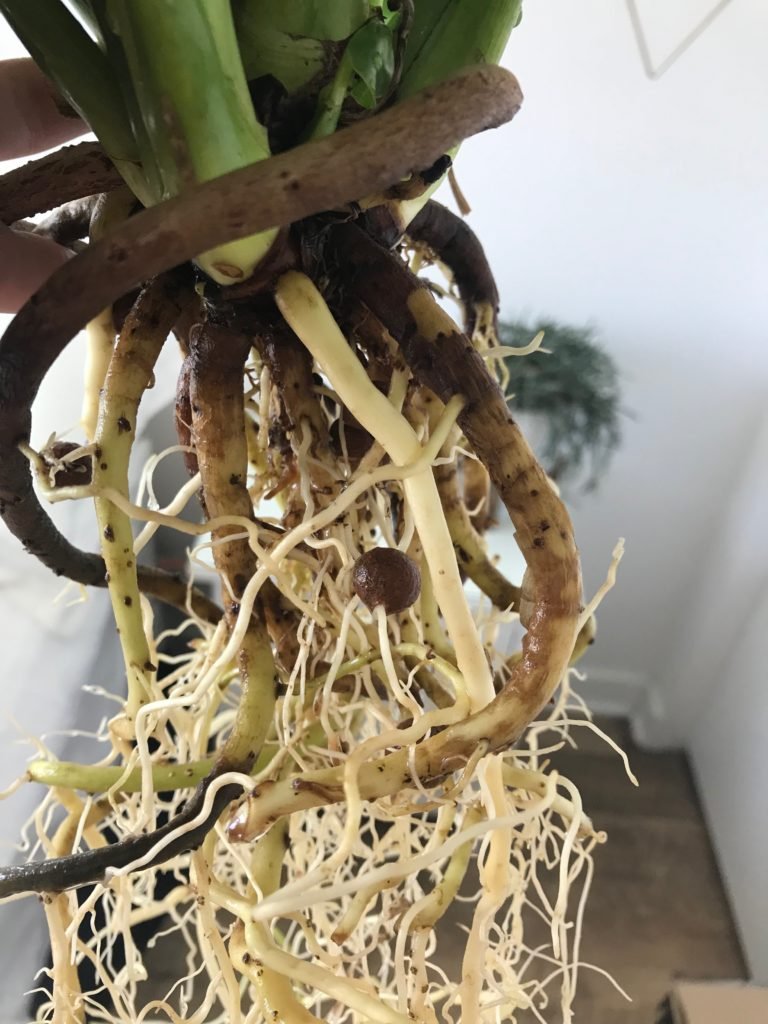
Mature Philodendron Selloum shedding outer layer of soil roots in Semi Hydroponics 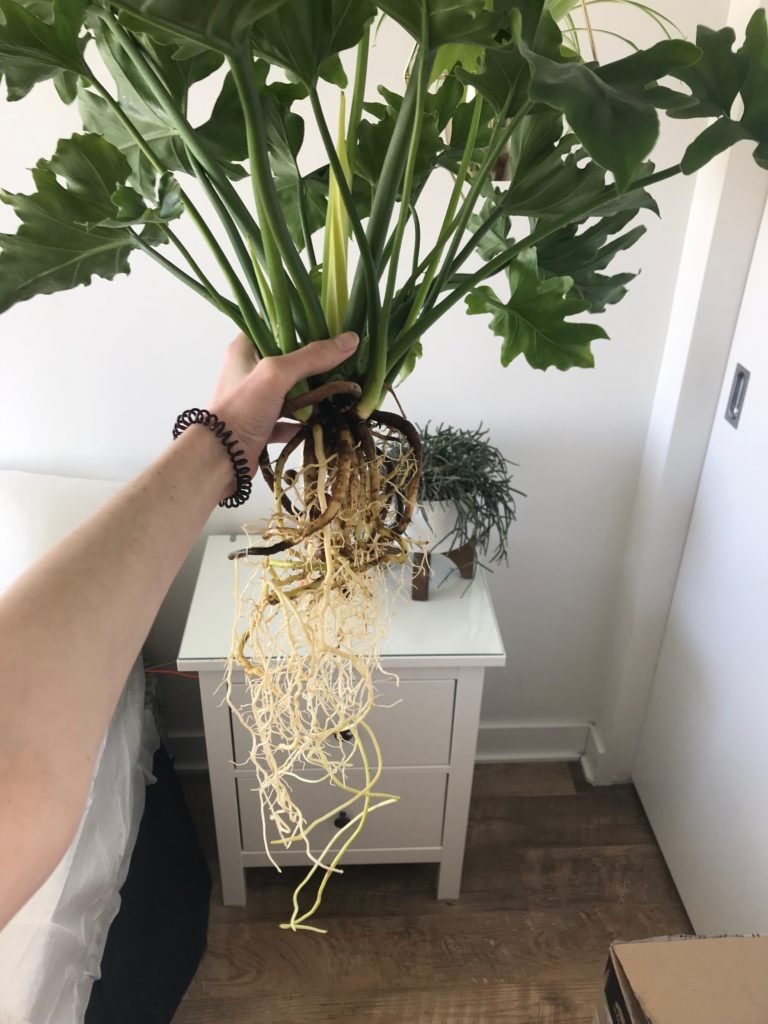
Philodendron Selloum Semi Hydro roots
Some plants will also shed the outer layer of their old roots while they grow new ones in LECA. This is nothing to be alarmed about and does not harm the plant. Any shedded plant waste can easily be removed with regular flushing. You should also remove the plant form LECA every few weeks to check on the root system and clean out any shedded root waste or roots that didn’t make the transition. As long as the plant is looking healthy and you are seeing new root growth, you shouldn’t be worried. It may also take a while before the plant starts pushing out new leaf growth since its energy is being directed towards adapting its root system.
If you’re nervous about converting a larger or more mature plant to semi hydroponics, it might be easier to propagate cuttings or divide it into sections to convert instead. Once you begin to feel more comfortable and get a feel for how it all works, you can move onto larger plants.
Final Thoughts
The great thing about growing houseplants in semi hydroponics is that it is somewhat uncharted territory and there really isn’t one right way to do it. If you’ve read my post on “How to Convert a Plant from Soil to Semi Hydroponics” you’ll see i’ve provided a step by step process on how I convert my plants.
While this is a great guideline for beginners, it doesn’t mean that with experience you can’t “bend the rules” and experiment to see what works best for you! The type of plant your converting, the condition its in, its root system and even variables such as the light, temperature and humidity in your home, can all play a role in determining how you want to go about converting your plants. So have fun and don’t be afraid to experiment!
The same principal applies for transitioning plants. There are no hard and fast rules or one method applies to all. Its all about trial and error and determining what methods work best for you with different types of plants and your home environment.
With that said, I hope the methods I’ve outlined in this post have shown you that with a bit of playing around, patience and will, you can grow almost any type of plant in semi hydroponics! From my experience, some plants do great going straight from soil to semi hydro, some benefit from a transition period, while others are easier to convert by propagating new roots altogether!
Happy Planting! ?
Disclaimer: Since the majority of this blog is sharing my personal experiences and advice on growing houseplants soil-free, I feel it necessary to state that I do not have a formal education in horticulture or hydroponics.The vast majority of my knowledge has been acquired through a lot of research, experimentation, trial and error, advice exchanged with other enthusiasts and a lot of hands on experience. I am not a horticultural expert. I am more of a self-taught hobbyist/enthusiast with a tremendous passion for continuous learning. The aim of this blog is to bring awareness to, guide and inspire others about using alternative methods for growing houseplants soil-free. Therefore, while this blog is meant to act as a resource and source of inspiration, it is important to understand that the decision to convert – and the vitality of – any plant converted to soil-free using the techniques outlined in this blog, is done at your own risk.
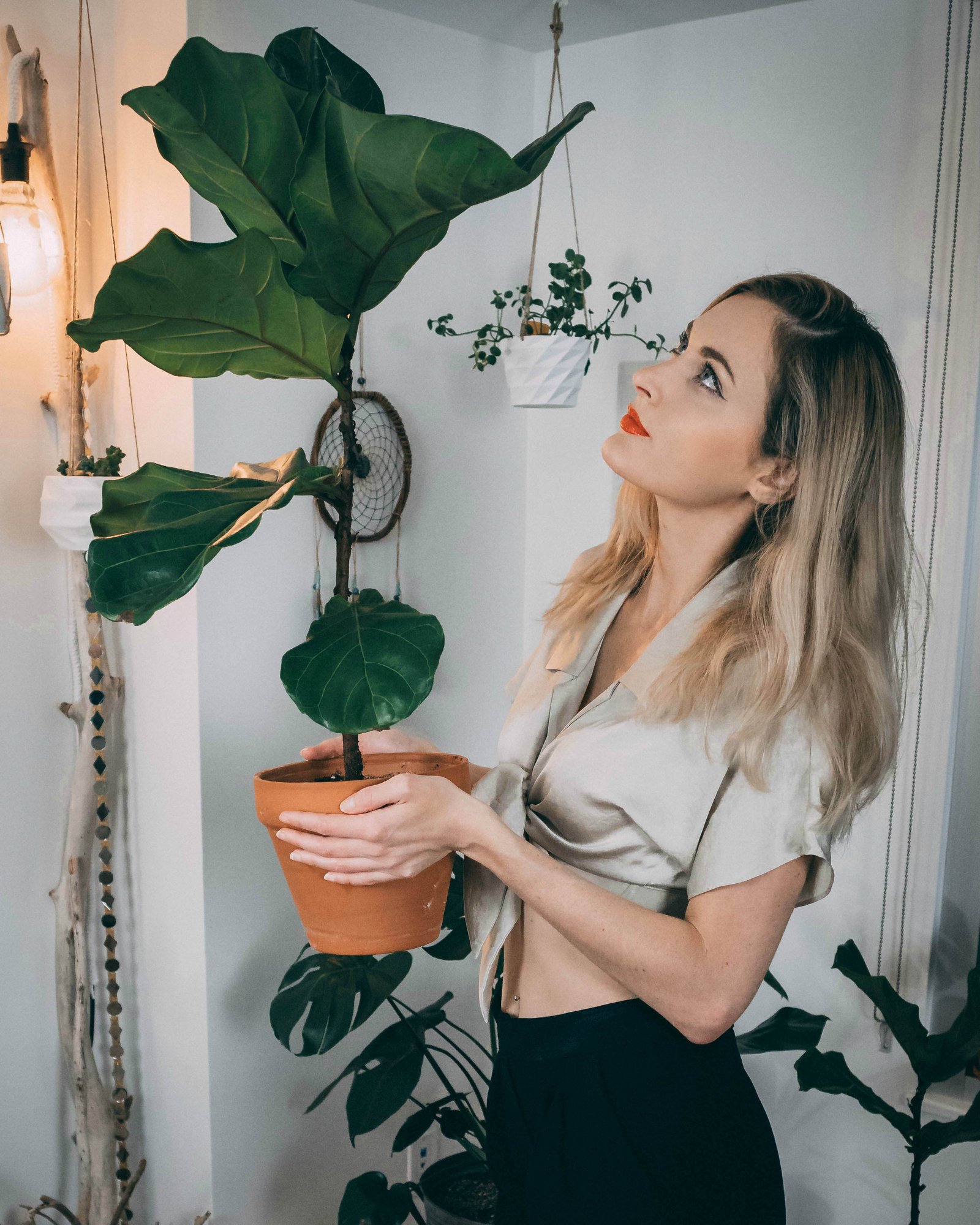
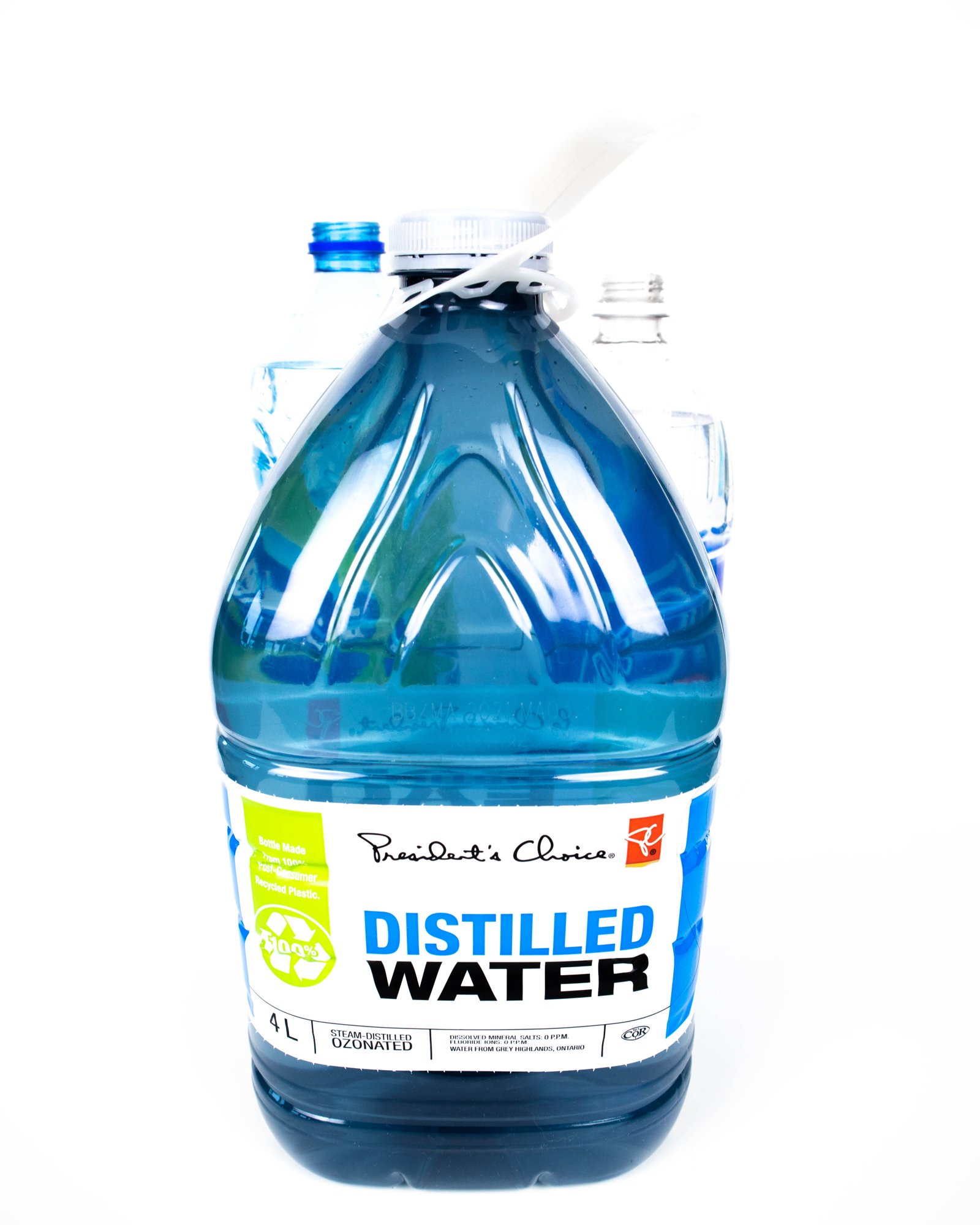
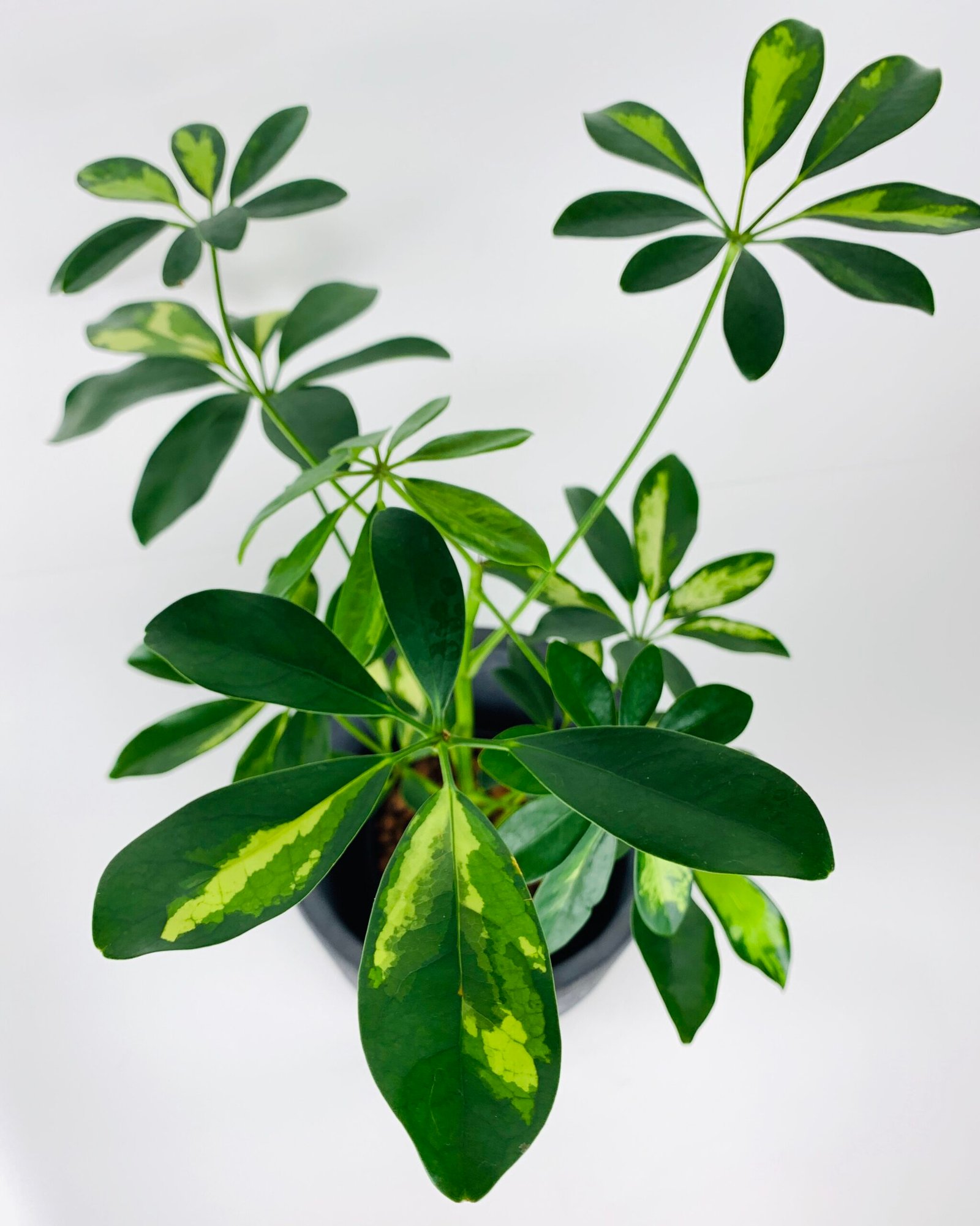
Jackie
I’m currently in the process of transitioning some of my plants to semihydro with the help of your posts and some YouTube videos!
I think my Hoya krimson princess is currently in shock after being planted in semi hydro, and as you mentioned it was likely after me trying to get all the soil out of it’s fine roots.
They’re now in leca propogation with just water and really hope they turn around. Some leaves and stems have gone limp and I’ve been babying this for the past few days hoping something will work.
Hoping I won’t have to cut off roots but will keep that in mind if the current setup doesn’t work. Just wanted to say this particular post was really helpful so thank you :)!
Georgia Gravel
Hi! In my experience I personally prefer to reroot hoyas altogether before switching them to semi hydro. I find the soil roots don’t do well going into a constantly wet environment and usually rot off, regardless of how well the soil was removed. I’m guessing that the reason your hoyas leaves have gone limp is because the soil roots are compromised and aren’t able to absorb water in the leca, so the plant is essentially becoming dehydrated. Usually when hoyas leaves are wilting despite watering it means the roots are suffering.
I experienced the exact same issues when I first started converting hoyas and I definitely need to write a blog on it! But i’ve since mastered converting hoyas to semi hydro and I have over a dozen that are thriving. First off, I never attempt to keep the soil roots when converting hoyas. I always trim/pull them off completely, otherwise they rot in leca. In my experience, to thrive in semi hydro, they really need to grow a brand new root system. Depending on the hoya, i’ll either cut the roots off, allow the end of the stem to callous over and stick it in water propagation (this works for hardier hoyas with woodier stems (carnosa, kerri etc), softer stemmed hoyas can go straight into water, no need to callous over, like hoya bella, australis etc) OR instead of cutting the roots off entirely, I just trim the roots but avoid cutting the stem itself (this helps to prevent stem rot, but also means the plant is less able to absorb water, so using a propagation box or a ziplock bag to keep the humidity high is really crucial – the extra humidity really gets roots growing like crazy vs just leaving the cutting in a vase of water out on a countertop). Once the cuttings have just started to root in water, I move to LECA propagation and then the roots really really take of! Once i’ve gotten a few inches of roots in just a jar with LECA, I move to semi hydro with nutrients. Hope this helps! I know cutting the roots off seems scary, but I haven’t lost a hoya using this method and I’ve never seen healthier roots on a hoya than I have in semi hydro. And remember, propagation boxes/ziplock bags are your best friend.
Vills
Hi
Most interesting. Just a couple of questions however, on water propagation or transition for such delicates such as marantas, do you use distilled water?
and do you add anything to the water such as hydrogen peroxide or SuperThrive to help shock and transition?
I’ve had my swiss vine in water for three weeks now, transitioned from soil to water due to root rot. It’s looking lovely and healthy, EXCEPT root system hasn’t changed except for some dying end bits, in fact root system seems to be getting smaller as I keep cleaning away dying root bits . Do you have to wait for new roots to emerge before moving from water to semi or wait for root ends to stop dying at least? Cheers 🙂
Georgia Gravel
Hi! Most of the time I find just plain tap water works fine for water propagation. I like to use superthrive if its a plant that is weak or struggling and could really use the boost to adjust from shock. For instance, I recently acquired a thai constellation monstera from an online retailer that imports from thailand. It wasn’t acclimated properly before the seller shipped it, which combined with the shipping meant that by the time it got to me it’s leaves were completely limp and its root system was more or less a dry shrivelled mess. So in cases like that I like to use distilled water with added superthrive to help the plant recover and bounce back and strengthen its root system before planting in semi hydro. But for the most part, if you have a healthy plant or cuttings, tap water usually works fine on its own, but adding superthrive would just help the roots grow even faster. When I move a plant to semi hydro I don’t usually add superthrive to help it adjust. Depending on the plant i’ll either use nutrients at half strength (1.25 ml of each nutrient) for a couple of weeks, or I’ll just use nutrients at full strength (2.5ml of each) if its already a healthy and robust plant.
For your swiss vine plant you could definitely move it to semi hydro if you wanted. It’ll likely continue to shed old soil roots and grow new roots adapted to LECA. The only downside is you’ll have to periodically remove the plant from the LECA to continue to clean away any root die off while you wait for the root system to change over. Some of the old soil roots might die off completely as new roots grow in, while other soil roots will just shed their outer layer and continue to grow more secondary roots. Keeping it in water does have the benefit of of being able to watch the whole process and then switch to semi hydro once its complete, but the downside would be the plant may experience stunted leaf growth. In my experience, once the plant has started growing in new roots from water propagation, its better for the plant to be moved to leca with nutrients since it gets the benefits of the airy oxygen rich media (oxygen is vital for root health) and nutrients to maintain steady growth. I’ve found if plants are left in just water for too long the leaves can revert to a more juvenile form instead of growing larger and more mature. Hope this helps!
Stella
Hi,
I have some very successful plants in leca. If the roots are heading into & sitting in the water of their own accord & the plant is healthy and happy do you leave them or repot them? Does it matter if they sit in the water once they’re adapted and happy?
Thanks.
Very helpful articles for new starters.
Georgia Gravel
Hi Stella! That’s awesome your plants are doing great in LECA! It sounds like you’ve successfully converted/transitioned plants and they’ve established themselves and are in the root abundance phase! The root systems of plants in LECA can get a bit crazy because the conditions for growth are just so favourable. I would recommend that every few months, it is worthwhile to remove the plant for the LECA and trim the excess root growth back. This helps prevent the root system from becoming crowded and blocking off the airflow that really helps the roots of plants in LECA thrive. Normally when you start seeing the roots in water that means one of two things 1) the root system has gotten a bit overgrown/excessive, or the reservoir is allowed to drop lower than the root system and the plant will automatically send out root growth to where there is the most moisture. If left unchecked, over excessive root growth can actually block the airspaces and deprive the roots of oxygen, which is why plants usually go through an adapting/transitioning phase when first moved to LECA, then a crazy growth spurt producing lots of new growth and foliage stage, and then seem to plateau when the roots get out of control. It’s actually beneficial to cut a lot of that root growth back, and even in some cases, just cut off the old roots and grow new roots altogether! Just think of it as a hair cut, just like a plants roots in LECA, it’s healthy for us to get our hair trimmed every once and a while! happy planting 🙂
Vills
Thanks for that. However i had to put my swiss vine back to water only till i work out what im missing. It did amazing on first day. But then Its leaves started drooping and looking very sad. Not sure if it was ready for Leca (it had been in water for three weeks prior to transfer). It had very few roots left but massive healthy leaves.
In trying to work out what I’m missing, i need to ask, if you dont mind. In terms of water temperature, does water have to be kept warm room temperature? Had it above chimney previously. I’m not sure how i will keep all my hydro plants warm in winter as i suspect water will get colder than soil..correct?
Or perhaps too early for nutrients to have been added, ie root burn?
And also, do plants take time to adapt or should they be doing well from the start? Not sure what to expect at the start of a transfer, any clues or insights would be handy.
Georgia Gravel
Hi Vills! Sorry I didn’t see your comment earlier! I’m guessing you’ve probably figured it out by now. If you find a plant like your swiss cheese is looking sad as soon as you try to transfer it, it could be in shock from too much damage to the root system when removing the soil. Luckily plants like swiss cheese are very easily propagated so its easy to regrow new roots in just water and/or LECA. Some plants also go through a bit of a shock as they are transitioning to a new medium so they may go through somewhat of a wilting or droopy looking phase before they bounce back. Colder temperatures or other factors like less light or lower humidity could also make it more difficult for a plant to adapt when transitioning. I usually add hydroponic nutrients once I see some new root growth, otherwise I might add some superthrive for a boost. Not all plants do well from the start. I’d say take all factors into consideration and use your best judgment. Was the plant healthy to start with? Did a lot of damage happen when removing the roots? or was all or most of the soil removed? Would it be easier to propagate new roots instead? Are the conditions in my grow environment ideal? Can I make them more favourable? Is it a hardy plant or a sensitive plant? It definitely takes patience and practice so don’t be afraid to have fun with it and experiment! Happy planting! 🙂
Zong
Hello! Best directions and blog! Thank you! I have a young but semi mature monstera that was extremely root bound. (A gift.) More roots than dirt… how much of the roots can I remove from the plant to transition into the semi hydro?
Georgia Gravel
Hi Zong! its hard for me to say since I can’t see the root system myself, but generally Monstera are very hardly plants so personally, if it were me, I would remove all the soil without damaging too many of the main roots, but also not being too concerned if I lose smaller roots in the process. Often, a potted monstera consists of several plants in the same pot, so I would separate each plant section after the soil is removed, assess the roots, cut off any that are damaged or overly long (probably about 1/3 to 1/2 by this point), thoroughly wash the remaining roots, and reassess whether to cut off more after as much (close to all) of the soil has been removed off the remaining roots. I’d say with a healthy, semi-mature monstera, I’d probably be left with about 1/3-1/4 of the roots remaining by the time I was replanting in LECA.
Rosanna
Thanks for these super helpful articles on semi-hydro. I haven’t transitioned any plants yet, but I’ll probably start with my cuttings currently in water. I have a couple of questions. How long do the roots need to be before they can be transferred to leca? Is it possible to keep a plant in the ‘leca propagation’ setup you described, or does it need to be moved to a leca inner pot and nutrient reservoir outer pot? Could I just add nutrients directly to the water in the bottom of the leca propagation container and have the plant grow there? It would be harder to flush clean I suppose, but is there any other reason the two pot method is better than one? Does that make sense?? Thanks!
Georgia Gravel
Hi Rosanna! Your cuttings are already ready for LECA whether they have roots or not if you keep them in a propagation setup – that is, having the cuttings in LECA in a jar/container keeping the waterline filled to at least 1/3 the height of the jar. You could keep them in this set-up almost indefinitely, even in just water and they’ll likely do just fine and not die, although in the long run they likely won’t really grow and flourish without nutrients. You definitely could keep them in a jar set-up rather than switching them over to the inner/outer pot method and just start adding nutrient solution. The reason why I don’t personally like to keep my plants in just a jar set-up over the long term is just out of convenience and practicality – it’s a lot easier to manage pH and flush excess salt/mineral build-up when using the inner/outer pot method, easier to remove the plant from the LECA, and easier to avoid any algae build-up that usually happens over time when in a clear jar exposed to light(although the reservoir does last longer in a jar). So technically, you could leave it in a jar, but you’ll have to make more of an effort when flushing and you might experience some algae build-up. I don’t think there should be any hard and fast rules, so in my opinion, do what works best and is easiest and most convenient for you and promotes the health of your plants! Have fun and experiment 🙂 Happy planting!